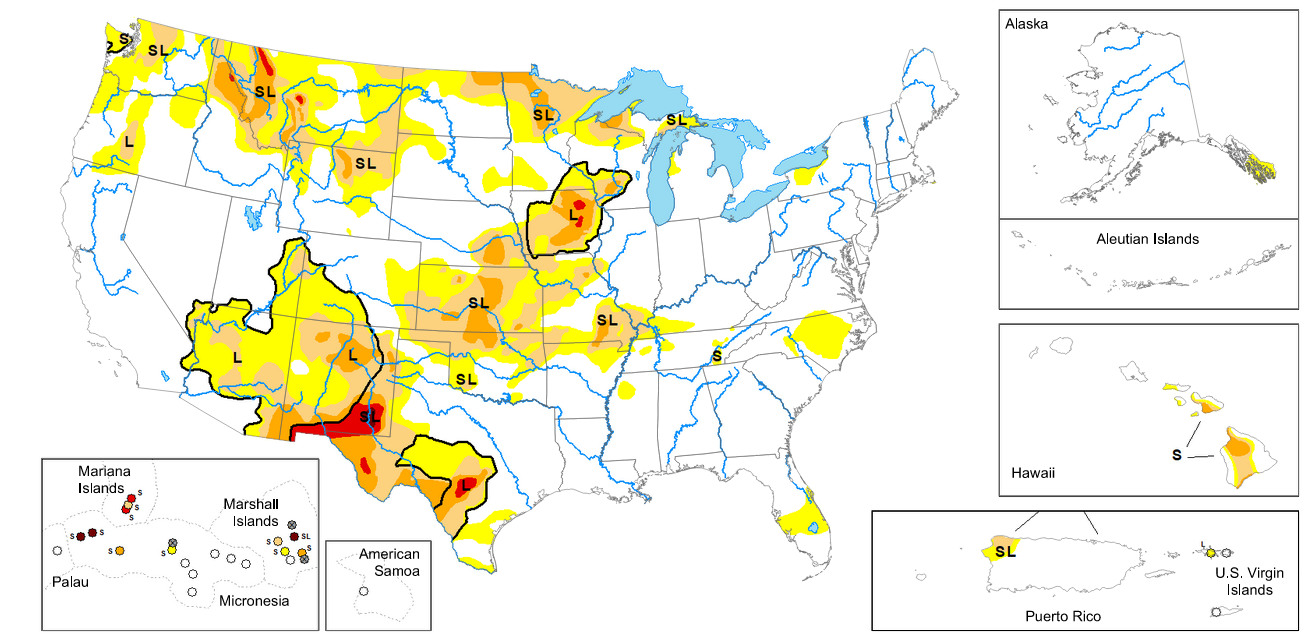Runoff Update and Season Fishing Forecast for June 1, 2024
Posted on June 1st, 2024
If you’ve been following our season fishing forecasts, you know that we saw a warm, dry winter here in Yellowstone Country. For much of the winter and spring, we’ve been anticipating dreadfully low water and tough conditions in late summer. Thankfully, May has largely been cool and very wet, so it seems likely we’ll avoid the worst impacts of the warm and dry winter.
This isn’t to say it’s all wine and roses. While remaining snowpack is above 90% of normal for the date in all of our key basins, and water year precipitation is close to normal, our peak snowpack was only 70% of normal or thereabouts as of May 1 and we remain locked in moderate drought. Long-range outlooks through early fall suggest hot/dry weather which will make these deficiencies worse. So we are still going to have low water for most of the season, and if the hot/dry forecast comes true this water will be very warm in late July and August. 2:00 closures are likely in many areas. This is still an improvement over previous outlooks, when we saw strong possibilities of complete fishing closures in many areas.
Overall, we now expect conditions similar to 2012, 2013, 2015, or 2016, rather than the extreme drought and record-low flows of 2007 and 2021. We’d much rather have the near-normal or above-normal flows of 2009, 2010, 2014, 2017–2020, or 2023, but we’ll take “not what we want but not catastrophic” over “the creeks are running dry and everything is on fire. Run for the hills!”
Snowpack, Runoff, and Predicted Summer Fishing Conditions Update for May 1, 2024
Posted on May 1st, 2024
Winter and early spring 2023-2024 have been warm and dry in Yellowstone Country, just like it has just about everywhere except California through Colorado. For a while we were flirting with record-low snowpack and the potential for a very short fishing season. After strong improvement from mid-January through March, April saw warm and dry weather with an accompanying sharp decline in snowpack and an early pulse of spring runoff (weeks early). We are unfortunately now looking at tough conditions again in late summer and early fall.
Because of anticipated low and warm streamflows and a forecast for a hot, dry summer, we encourage anglers to visit sometime between June 15 and July 15 if you’re looking for consistent summer-type fishing with dry-dropper combos, fast, cold flows, etc. July 20 through August are likely to see very low water and widespread 2:00PM mandatory closures. Early September will see better conditions, but low, clear water will still make for difficult fishing on sunny days. Only in October and November can we be sure of aggressive fish again.

Current United States drought conditions. Our area of SW Montana and NW Wyoming ranges from abnormally dry (yellow) to severe drought (orange).
Snowpack Update and Summer Streamflow and Fishing Forecast for April 19, 2024
Posted on April 19th, 2024
Winter and early spring 2023-2024 has been warm and dry in Yellowstone Country, just like it has just about everywhere except California through Colorado. For a while we were flirting with record-low snowpack and the potential for a very short fishing season. After strong improvement from mid-January through March, April has seen a decline in snowpack and we’re looking at tough conditions again in late summer and early fall.
Because of anticipated low and warm streamflows and a forecast for a hot, dry summer, we encourage anglers to visit sometime between June 20 and July 20 if you’re looking for consistent summer-type fishing with dry-dropper combos, fast, cold flows, etc. July 20 through August 20 are likely to see very low water and widespread 2:00PM mandatory closures. August 20 through September will see better conditions, but low, clear water will still make for difficult fishing on sunny days. Only in October and November will we be sure of aggressive fish again.
With Yellowstone Park opening portions of the Gardner and Madison Rivers to year-round fishing beginning November 1, this may be a year to skip August and come in early November instead, especially if you’re an angler who likes to walk-wade and doesn’t mind cold weather fishing.
Anglers who visit in late summer and early fall are strongly advised to be flexible as far as destinations, tactics, trip start times (we will likely want to meet before dawn) and durations (morning half-days might be the way to go in August) and even target species. Anglers here on August 15 up for doing oddball stuff like throwing grasshoppers for carp might be a lot happier than anglers who insist on trying to fish the same flies on the mellowest stretches of Paradise Valley on the Yellowstone on the same date…
Read More…